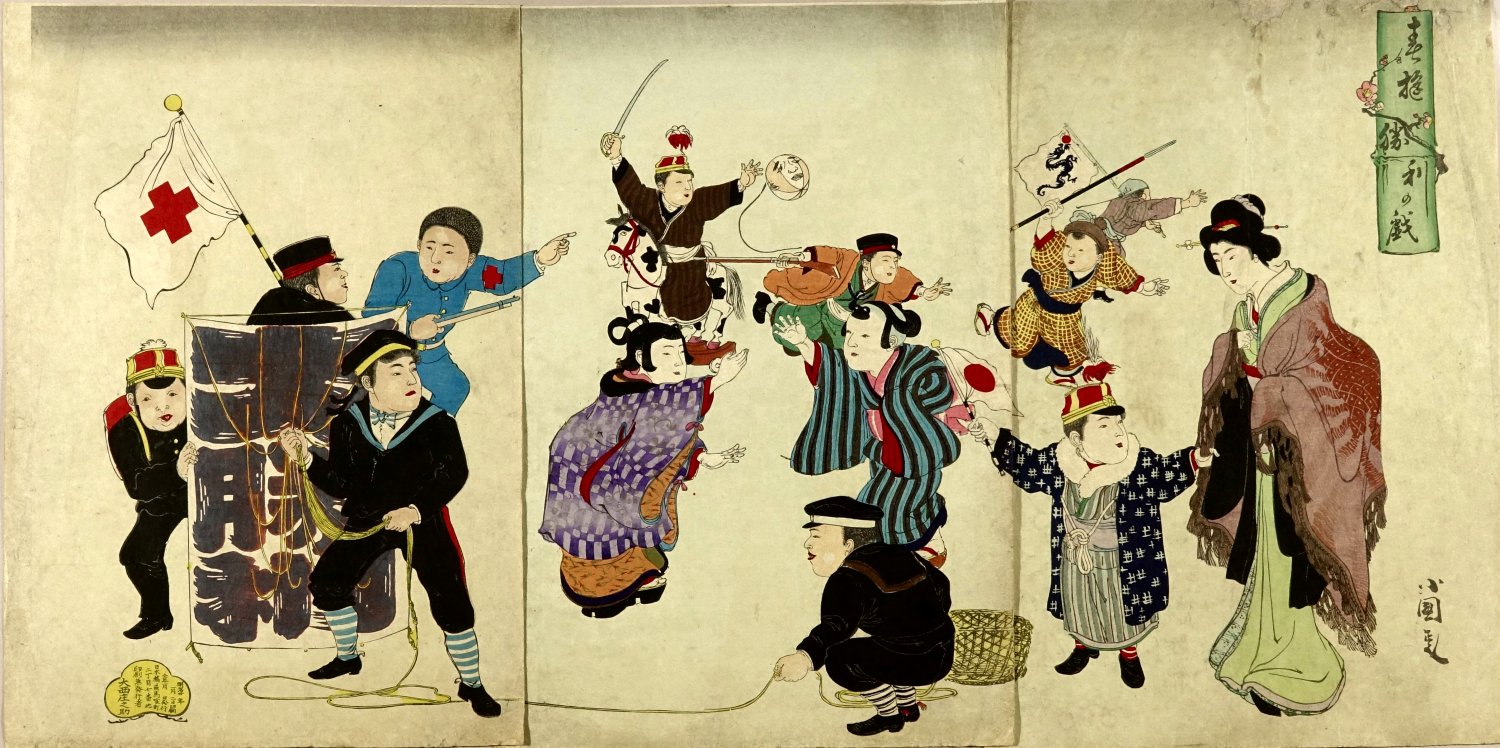| |
KOKUNIMASA
|

"Springtime Drama of Playing
Victory"
("Haru asobi shori no tawamure", "春遊勝利の戯")
1895
Two additional boys behind the kite obviously belong to the mock paramedic team, holding a Red Cross flag or a Red Cross badge on a sleeve. Two boys in the upper central panel are representing cavalry and ground force. The boy sitting on the wheeled toy horse wears a double coloured white and red crest, representing the colours of the Japanese flag. He is traditionally clothed, and is obviously an officer. With his drawn saber and his rifled ground man, he is chasing two other boys, fleeing in their sandals from the glorious aggressors. The officer on horseback has just beheaded an enemy, represented by a ball with a face. Both traditionally clothed "enemy" boys have to play the part of the fleeing Qing troops. The the "fleeing" boy in font carries a lance, the background boy carries a Qing Army war flag (dragon with read pearl).
The right panel shows a classical dressed woman with a male child to her right. The small boy wears classical winter children's attire, and has an officers hat with a white and red crest. He carries a Japanese flag, and pulls the lady, maybe his mother, towards the two children in the middle of the center panel. Judging by the hairstyles, the two children in the center of the composition may be a girl to the left, and a boy to the right, both are classically clothed, and wear getas. They seem to be arguing.
The title of the print ("春遊勝利の戯") is written on the bamboo section cassette on the opper right of the right panel. A blossoming Japanese cherry branch (prunus serrulata), botanically a type of plum tree, twines around the bamboo. May be a reference to the date of the print for the time of the war (January 2, editor's cassette, left panel, lower left). Otherwise, the blooming cherry twig may be more of a pure decorative element.
Series - 'unserialized' triptychs commenting the First Sino-Japanese War, reenacted by children. This 'non-series' includes the prints "Japanese Spirit: Battle of the Infants" ("Nihon-damashii: eiji no tōsō", "日本魂: 嬰児の闘争") and "Children's war games" ("Yōchi asobi shison no kensō", "幼稚遊ひ子孫の諠争"), both printed end of 1894, but from publisher Hasegawa Sonokichi.
Artist - see Biography
Signature - "KOKUNIMASA" ("小国政") on the right panel lower right
Publisher - Ōnishi Shōnosuke (大西庄之助)
Image Size - 75.9 X 25.1 cm (29 7/8" x 9 7/8")
Condition - triptych; nishiki-e (cloured woodblock); Vertical ôban (ôban tate-e)
("Haru asobi shori no tawamure", "春遊勝利の戯")
1895
Comment - A scene, commenting the First
Sino-Japanese War (1894-06~1895-04), reenacted by children.
Two boys on the left panel are holding a correctly tangled Edo kite ("Edo-tako", "江戸凧"
for lift off. The typical tail ropes of the Edo are missing.
The kite contains a kanji
character (not read, partly concealed). The boy holding the
kite from behind wears a toy uniform with an Imperial Army
officers hat, and carries a red military satchel. The boy in
front of the kite wears a navy uniform with a matching cap. He
has grasped the
bridle lines with his right hand and is waiting for the
start. The lower right center panel shows a crouched boy
with the flying line in his left hand, a basket for the
flying line to his right. The boy is also wearing
an appropriate navy uniform and cap.
Two additional boys behind the kite obviously belong to the mock paramedic team, holding a Red Cross flag or a Red Cross badge on a sleeve. Two boys in the upper central panel are representing cavalry and ground force. The boy sitting on the wheeled toy horse wears a double coloured white and red crest, representing the colours of the Japanese flag. He is traditionally clothed, and is obviously an officer. With his drawn saber and his rifled ground man, he is chasing two other boys, fleeing in their sandals from the glorious aggressors. The officer on horseback has just beheaded an enemy, represented by a ball with a face. Both traditionally clothed "enemy" boys have to play the part of the fleeing Qing troops. The the "fleeing" boy in font carries a lance, the background boy carries a Qing Army war flag (dragon with read pearl).
The right panel shows a classical dressed woman with a male child to her right. The small boy wears classical winter children's attire, and has an officers hat with a white and red crest. He carries a Japanese flag, and pulls the lady, maybe his mother, towards the two children in the middle of the center panel. Judging by the hairstyles, the two children in the center of the composition may be a girl to the left, and a boy to the right, both are classically clothed, and wear getas. They seem to be arguing.
The title of the print ("春遊勝利の戯") is written on the bamboo section cassette on the opper right of the right panel. A blossoming Japanese cherry branch (prunus serrulata), botanically a type of plum tree, twines around the bamboo. May be a reference to the date of the print for the time of the war (January 2, editor's cassette, left panel, lower left). Otherwise, the blooming cherry twig may be more of a pure decorative element.
Series - 'unserialized' triptychs commenting the First Sino-Japanese War, reenacted by children. This 'non-series' includes the prints "Japanese Spirit: Battle of the Infants" ("Nihon-damashii: eiji no tōsō", "日本魂: 嬰児の闘争") and "Children's war games" ("Yōchi asobi shison no kensō", "幼稚遊ひ子孫の諠争"), both printed end of 1894, but from publisher Hasegawa Sonokichi.
Artist - see Biography
Signature - "KOKUNIMASA" ("小国政") on the right panel lower right
Publisher - Ōnishi Shōnosuke (大西庄之助)
Image Size - 75.9 X 25.1 cm (29 7/8" x 9 7/8")
Condition - triptych; nishiki-e (cloured woodblock); Vertical ôban (ôban tate-e)
Copyright 2008 ff: Hans P. Boehme